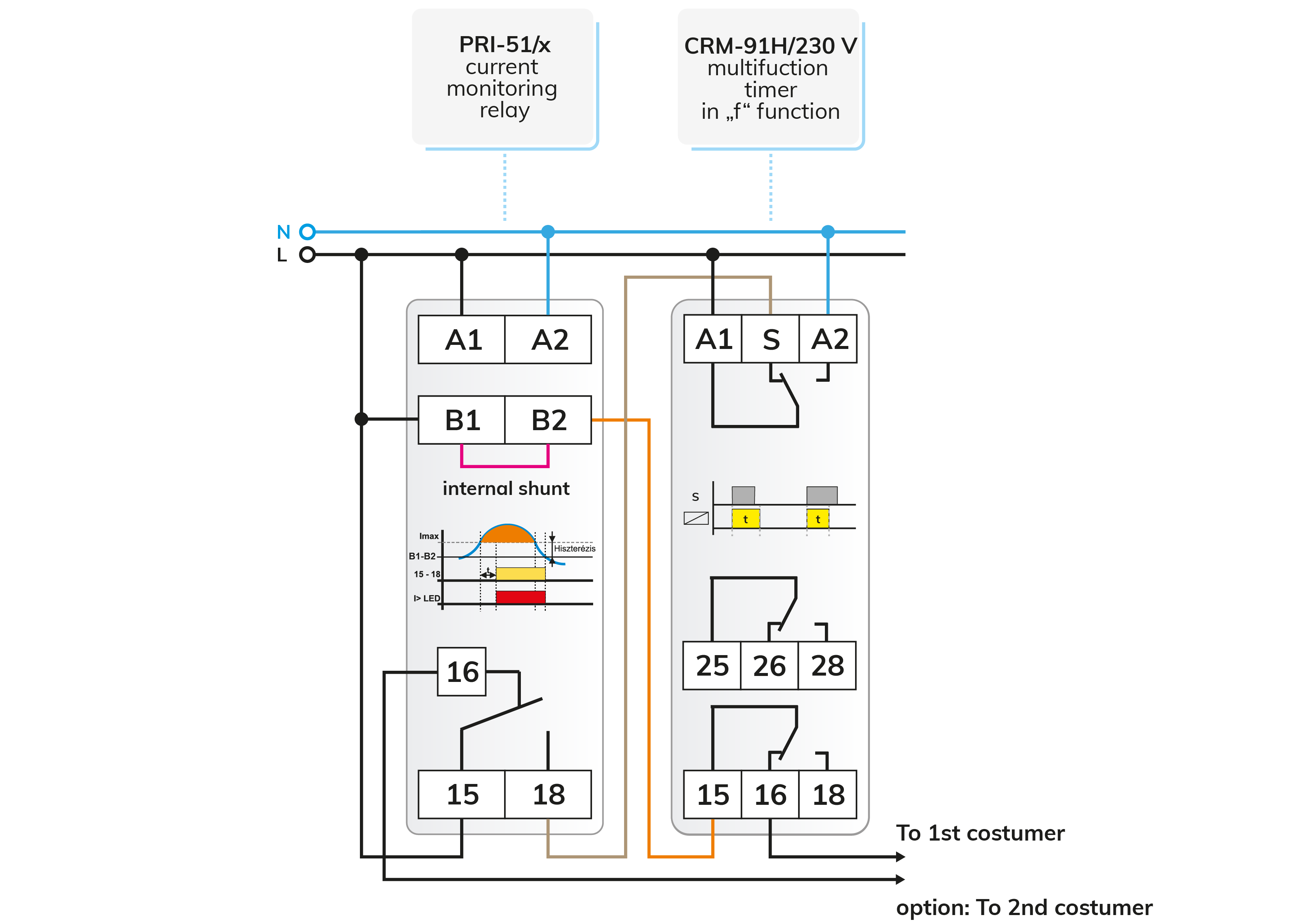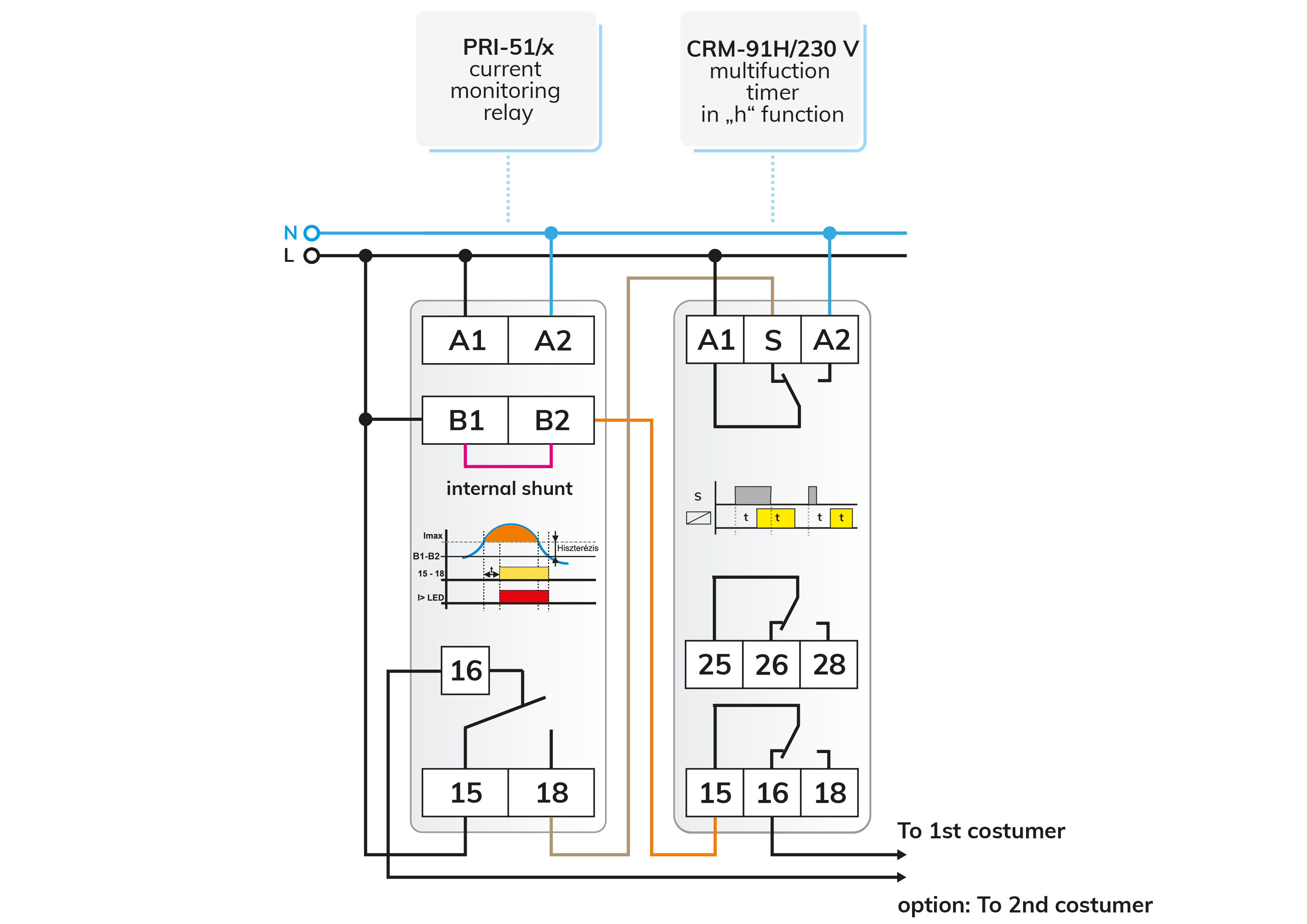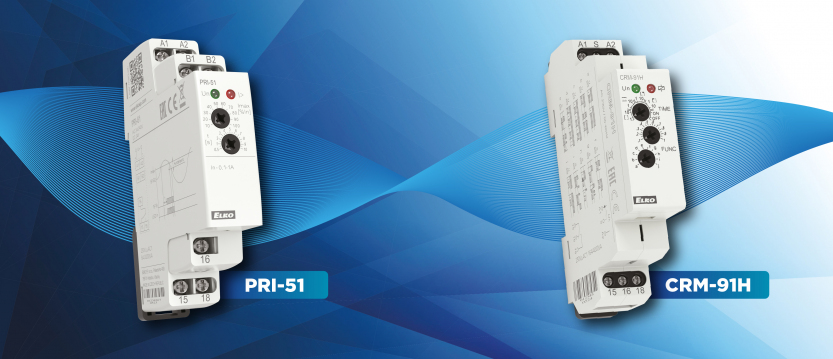Operating our machines with precise timing is not a challenge when using time relays, especially multifunction types. Manufacturers integrate the most common and frequently required functions into these time relays, simplifying user familiarity with just one device. This increases the likelihood of selecting the correct timing function and effectively controlling the device.
However, situations may arise where direct installation of a time relay is not feasible due to factors such as limited space or absence of control wires. Nonetheless, if space is not an issue, there may be room in the control cabinet. Even if devices are typically activated locally rather than from the control cabinet, it is crucial to detect when they are powered on.
In such cases, current monitoring relays prove valuable as they monitor the supply line at the point of connection. When the consumer is powered on, current flows through the power line, triggering the current monitor to send a start signal to the timing relay.
Several current monitoring solutions are available, primarily utilizing
PRI-51/x current limit switches (where x denotes the monitored maximum current). These switches come in various current ranges, simplifying the selection process for the appropriate type based on the consumer's current. The relay in the PRI-51/x current monitors activates when the measured current surpasses the set point. Therefore, to detect consumer operation, the set point must be below the consumer's current consumption, ensuring the relay activates during consumer operation.
Timed disabling of a high current consumer
Figure 1 illustrates an interesting application for the utilization of current monitoring relays. The setup is designed to limit consumption (and subsequently costs) by temporarily disabling and disconnecting the power supply voltage when consumption exceeds a certain threshold.
Once the timer elapses, reconnection is attempted. However, reconnection is only permitted if the high-current consumer has been disconnected; otherwise, the power cord will be switched off again after a delay (if configured) for the predetermined duration.
In more extreme cases, such switching mechanisms can even be employed to deter power theft in communal areas of larger communities, thereby reducing shared costs. Naturally, adherence to safety regulations, which are not detailed in this circuit, is essential and must be incorporated to suit the specific environment.

The two modules can be installed in the control cabinet by monitoring the supply line of the consumer circuit, enabling retrofitting without the need for special wiring or disconnection. The power supply line of the consumer circuit passes through the internal shunt (B1 - B2) of the PRI-51/x current monitor.
From there, it proceeds to the common terminal 15 of the output relay of the time relay, and then to the consumers via the remaining contact (16). If a higher current consumer than the Imax set on the current monitor is switched on in the monitored power line, the current monitor relay energizes pin 18 to the “S” input of the
CRM-91H time relay.
The time relay, supplied with constant power, is configured for the release delay function triggered at the rising edge of the control signal "f". The time value is adjusted according to the application's requirements. Upon initiation, the time relay commences its timing and interrupts the voltage supply to the consumer circuit.
This action de-energizes the monitored power line, causing the current monitor relay to return to its idle state. After the predetermined time period elapses, the time relay re-establishes the supply line voltage. If the current consumption has returned to normal and is below Imax, the circuit solely serves a monitoring function.
However, if the current consumption remains high, the shutdown process repeats. Eventually, someone seeking to utilize excess power will be prompted to disconnect their high-current consumer from the grid.

Timed operation of a Consumer
The circuit's connection remains unchanged from the previous one, but the time relay is configured for the delayed pull-on and release function "h" based on the control signal. In this function, the time relay initiates the delayed switch-on upon the rising edge of the control signal "S". After a duration of time "t", the relay is energized. Subsequently, the delayed release begins upon the falling edge of the control signal, and the relay switches off after another "t" period. Both time variants are identical, as the CRM-91H time relay offers only one time setting option.
The operational disparity compared to Figure 1 lies in allowing higher current reception for a duration of "t", with the objective of timing the consumer's operation from the supply side. The release delay function primarily serves to prevent consumers from being rapidly switched on and off for the same duration of "t", a useful feature for devices sensitive to quick cycling.
Notes
- The locking of another circuit by the idle contact 16 of the current monitoring relay is applicable to both circuits, prioritizing higher current consumers passing through the shunt.
- If the current consumption of consumer circuit 1 is below Imax, the priority does not apply, and both consumer circuits can operate concurrently.
Attention! The solutions presented in the articles are illustrated with conceptual circuit diagrams in which, despite repeated inspections or tests under workshop conditions, errors may occur. It is the installer's task and responsibility to check their suitability for a given task and to make any changes! The author and the company do not accept any liability for damages or other problems resulting from the use of the presented solutions. The colors of the wires in the drawings only help for easier transparency, they do not necessarily match the colors of the standard wiring!
